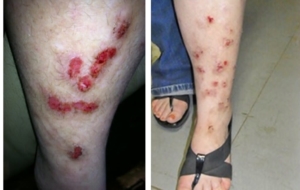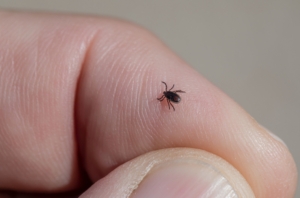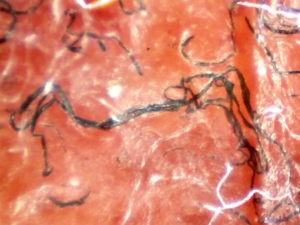Finding A Doctor Can Be A Challenge For Morgellons Patients
Morgellons disease has enough in common with Lyme disease that finding a knowledgeable doctor can be difficult. But the cost of not finding one is even greater.
If you feel you have Morgellons and need to find a doctor who understands, keep reading to learn what’s at stake and how you can best get help and understand this often mischaracterized disease.
Patients with Morgellons disease suffer from slow-healing open sores, extreme fatigue, and a host of other symptoms, including joint pain, heart problems, crawling skin sensations, and mental decline.

Morgellons Disease Lesions on Body with Scarring
Unfortunately, because Morgellons isn’t widely recognized, many patients suffer without knowing the root cause of their symptoms. Morgellons patient symptoms are often dismissed as a delusional disorder because patients feel like something is crawling through their skin and insist that something is wrong with them.
Unable to explain these symptoms, doctors conclude that patients are experiencing a psychotic event and scratching themselves, causing open sores. It’s no big surprise since the Center for Disease Control’s landmark research missed the mark by characterizing the disease as a mental and physical deterioration loop that preys on itself.
Physical symptoms of Morgellons, they said, compound on pre-existing insecurities, anxiety, and mood disorders. The mental anguish, in turn, feeds the physical manifestations, deepening the hold of the mental problems just to repeat the loop again.
Dismissive medical professionals aside, real, erratically growing fibers embedded deep within the skin cause Morgellons patients’ skin discomfort. These fibers are a hallmark identifier of Morgellons disease but can only be seen by handheld light microscopes under 50x magnification.
Compared to collagen and keratin fibers, the normal structural fibers found in skin, Morgellons fibers are so large that patients can sometimes feel them growing between their tissues. That constant creepy-crawling sensation is nerve-wracking enough to come across as a mental disorder. Add to that disfiguring skin sores, extreme fatigue, and debilitating joint pain, and it’s no wonder many Morgellons patients experience a poor quality of life.
Sadly, too many Morgellons patients suffer silently and without hope as doctors dismiss symptoms as psychological issues and they never receive needed treatments. As a result, patients continue to suffer because their symptoms are masked instead of resolved.
Through ground-breaking research funded by the Charles E. Holman Morgellons Disease Foundation, we now have evidence that Morgellons is more than a delusional disorder:
Morgellons is a genuine somatic illness caused by an underlying bacterial infection and can be treated, or at least managed, with an antibiotic regimen.
Pathogenic infection
 Nearly all Morgellons patients studied tested positive for a Borrelia burgdorferi infection, or Borreliosis. Borrelia burgdorferi is the same bacteria that causes Lyme disease and is in the same classification as the bacteria that causes Syphilis—both are spirochetes.
Nearly all Morgellons patients studied tested positive for a Borrelia burgdorferi infection, or Borreliosis. Borrelia burgdorferi is the same bacteria that causes Lyme disease and is in the same classification as the bacteria that causes Syphilis—both are spirochetes.
Morgellons patients “catch” the disease after being bit by the black-legged tick. The tick carries the infection in its gut, sharing it anytime it feeds on a new host—including humans.
Unfortunately, many tick bites go unnoticed. Patients may not even realize a tick bit them after visiting tick-infested areas and are left puzzling through emergent symptoms months or even years later.
Borrelia burgdorferi is a flagellated spirochete; this means that the long, narrow body of the bacteria has many whip-like tails that it can use to “swim” through fluids and tissues. The spirochete is much smaller than human tissue cells and can quickly move through dense tissues or even pass through cell walls—well out of reach of a patient’s white blood cells.
This spirochete is so good at moving around it can outrun a patient’s immune cells and doesn’t need to travel through the bloodstream to spread throughout the body. Left untreated, the pathogen can disseminate or travel to other body areas and invade cells far from the infection site.
Morgellons patients suffer from many different symptoms because the infecting spirochete spreads prolifically. In many studies, live Borrelia burgdorferi colonies were found in the heart, connective tissue, brain, and nerve cells.
Diagnosis
The key to successful borreliosis infection treatment depends on early identification and antibiotic therapy. However, for several reasons, only some patients can get the help they need.
One of the most significant setbacks for patients is that since the underlying spirochetal infection can lie dormant for months or even years before symptoms manifest, many patients don’t know they need medical help. When symptoms do manifest, the bacteria have built a stronghold within the body, spreading so prolifically that it’s nearly impossible to eradicate.

Morgellons Disease Fibers Magnified Specimen
The other major hurdle patients face is that many medical professionals are either unaware of Morgellons disease or deny that an infectious agent causes it. That is to say that many doctors aware of Morgellons chalk it up as a delusion and send patients off for psychiatric care instead of antibiotic therapy. That of course, reinforces or even creates anxieties and may actually feed the negative mental/physical feedback loop the CDC described.
The fact that testing for Borreliosis presents many challenges doesn’t help matters either:
- Blood testing inaccuracies result in many false negatives
- Cultural growth and staining are time-consuming and expensive
- DNA testing for the bacteria is both expensive and may be inaccurate as the DNA in laboratory strains of the bacteria differ from strains in the wild
Looking for characteristic Morgellons skin fibers using hand-held light microscopy is the easiest and most effective way to diagnose Morgellons disease clinically, but not enough medical professionals know to use this technique.
It’s true that bull-eye rashes, or erythema migrans rashes, are a tell-tale sign of a tick bite and an underlying Borrelia burgdorferi infection. Still, only a handful of people develop the rash, so it’s no reliable metric for infection diagnosis.
If these symptoms resonate with you, there is still hope.
Finding hope
By funding research and grass-roots efforts, the Charles E. Holman Morgellons Disease Foundation is helping spread more awareness for this debilitating disease. Through donation collections, we can fund essential research and educate the public and the medical community about Morgellons so that more doctors become sympathetic toward patients’ suffering and willing to treat the underlying infection.
For patients who feel they have exhausted every avenue, we ask that you click here to find a doctor who may be willing to help you. Additionally, please enter your demographic data into the registry we have created that assists scientists in tracking and researching this disease.
Please donate to our foundation today to help stop misdiagnosis, improve our education and doctor network, and fund the research that will counter the harmful CDC findings that more than a decade of research has dispelled.
Donate

